Suspended Animation #206
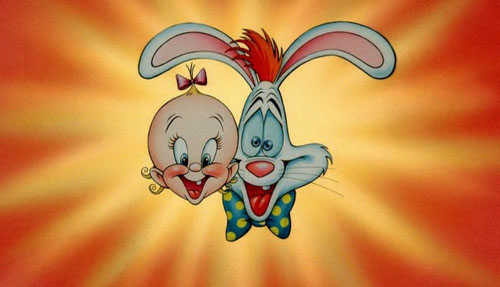
Last year marked the 30th anniversary of the acclaimed film Who Framed Roger Rabbit (no question mark at the end because of a Hollywood superstition that films with questions marks at the end do not succeed at the box office), released in June 1988.
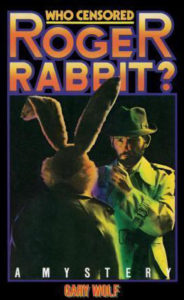 Disney President Ron Miller, against the advice of CEO Card Walker, purchased the rights to Gary Wolf’s 1981 book Who Censored Roger Rabbit for $25,000, even before it was published and put it into development. He felt it would be a good project to interest and utilize the talents of the newest animators hired from CalArts including Brad Bird and Glen Keane.
Disney President Ron Miller, against the advice of CEO Card Walker, purchased the rights to Gary Wolf’s 1981 book Who Censored Roger Rabbit for $25,000, even before it was published and put it into development. He felt it would be a good project to interest and utilize the talents of the newest animators hired from CalArts including Brad Bird and Glen Keane.
Gary Wolf’s book was meant to be a surreal spoof of the hard-boiled detective novel, a mixture of Raymond Chandler, Lewis Carroll and Warner Brothers. Roger Rabbit was a six-foot tall rabbit (a height which included his 18-inch tall ears) who worked for the DeGreasy Brothers.
He wore a baggy pair of shorts held up by brightly colored suspenders. His white stomach, nose, toes and palms on a light brown body made him resemble someone who had just walked face first into a freshly painted wall of white paint.
Within the first fourth of the book, he is killed. However, earlier that evening he mentally created a duplicate to go out and buy some red suspenders. Toons could create these temporary doppelgangers to perform the dangerous stunts in cartoons. Roger put a large jolt of mental energy into his duplicate so that it will last awhile before it falls apart.
The book then becomes a race against time as detective Eddie Valiant and the Roger duplicate try to find out who shot Roger and why, clear Roger of charges in Rocco DeGreasy’s murder, and figure out how Jessica fits in to the scheme.
Roger was more a comic strip character than an animated star, although he was still a foil to Baby Herman. When Toons talked, dialog balloons physically appeared over their head with the words spelled out, and these balloons eventually disintegrated, leaving fine dust.
The motivations and personalities of the major characters like Roger, Jessica and Baby Herman are significantly different than the final feature film versions.
In 1981, the talent behind the first attempt to bring Roger Rabbit to the big screen was Tom Wilhite, then currently head of production; Marc Stirdivant, a studio producer; and Darrell Van Citters, one of Disney’s top animation directors.
All three were key in developing much of the early Roger material along with character designer Mike Giaimo. Joe Ranft, Chris Buck and Randy Cartwright joined the development unit that operated from roughly 1981-1983.
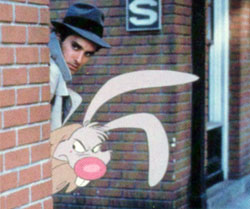
From the 1983 Annual Report
Buck and Cartwright produced some pencils tests and a short segment of colored animation that was only shown once on a 1983 Disney Channel show called Disney Studio Showcase where animation historian John Culhane was discussing new projects at the studio.
Portraying Eddie Valiant in the clip was longtime Disney performer Peter Renaday who remembers spending “one unremarkable day” filming the footage. He was made to look like a rougher character with a scuffy beard. A clean cut Eddie Valiant was portrayed by animator Michael Gabriel in some publicity photos.
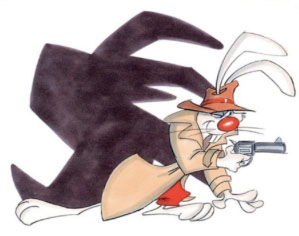 Paul Reubens voiced Roger and Russi Taylor provided the voice for Jessica Rabbit who at that time was more of a Lauren Bacall/Katharine Hepburn slender femme fatale and possible villainess.
Paul Reubens voiced Roger and Russi Taylor provided the voice for Jessica Rabbit who at that time was more of a Lauren Bacall/Katharine Hepburn slender femme fatale and possible villainess.
As Darrel Van Citters remembered, “Roger was to be voiced by the then barely known Paul Reubens. Paul had both an excitability and a naïve quality to his voice that we felt was essential to the character’s personality. Despite his firmly established role as Pee Wee Herman, Paul is an excellent voice actor, and gave us exceptional readings.
“We patterned Roger’s appearance after both Tex Avery and Bob Clampett design sensibilities. For some reason, big noses figure prominently in many of their character designs. This was for us the archetypal cartoon look. We had no interest in a more complex style—the purpose of this simple comic design was to belie Roger’s interior, for our aim was to imbue an outwardly zany character with emotional depth and heart.
“We chose to play against Baby Herman’s appearance with a rather haughty Ronald Colmanesque voice. To make him an elitist actor who resented his typecasting in films and lived, instead, for ‘the theater.’”
Peter Seaman and Jeffrey Price had completed a screenplay, Malta Wants Me Dead, which was eventually produced by Disney as Trenchcoat (1983). They were assigned to the Roger Rabbit development unit and provided several screenplay versions. Later, Lowell Ganz and Babaloo Mandel were contracted to provide another screenplay for a Roger Rabbit feature film.
When the dust settled in 1984, Michael Eisner and Frank Wells were now in the driver’s seat. Work on Roger had continued for awhile under Van Citters who was now working on the special project Sport Goofy which would never see its intended theatrical release but was shown instead on NBC in 1987. It featured a brief cameo of Roger in the stands.
 The Roger Rabbit film was no longer considered an active project as new administrations usually abandon things developed by their predecessors. However, Jeffrey Katzenberg did dig around in the files and discovered the work that had been done on Roger Rabbit and shared it with Eisner who put the project back into development.
The Roger Rabbit film was no longer considered an active project as new administrations usually abandon things developed by their predecessors. However, Jeffrey Katzenberg did dig around in the files and discovered the work that had been done on Roger Rabbit and shared it with Eisner who put the project back into development.
At the time, to save on Disney’s upfront costs, Eisner tried to interest outside talent in various co- productions. One such talent was Steven Spielberg. Looking over a list of potential properties, Spielberg eyed Roger and requested the film.
Disney had still planned to do the animation, but Spielberg’s Amblin Productions would be handling the majority of work. This marriage of studios also makes Roger one of the few Cartoon Superstars to be “joint” property, a situation that greatly influences where and how Roger is allowed to be used.
For a director, Spielberg chose Robert Zemeckis, who had just finished work on Back to the Future (1985). Zemeckis had been offered the director’s job on the film in 1982 by Wilhite. At the time he turned it down feeling the Disney studio wasn’t willing to put the necessary money behind the project.
Another one of Spielberg’s decisions was that he didn’t think the Disney staff of animators could meet the needs of doing the film. He looked at any animation director who had done live action and animation including such diverse talents as Don Bluth and Phil Roman.
There was even some discussion of setting up an entirely new animation studio in Northern California under the direction of Lucasfilms, which was already set to do the special effects work. Finally, all parties agreed upon the award winning director Richard Williams and work began — and the rest is history.


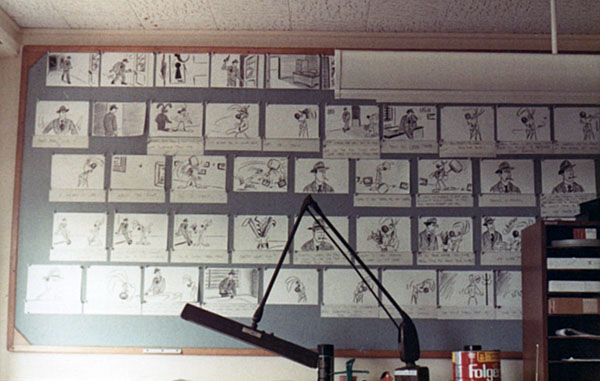
 Jim Korkis is an internationally respected animation historian who in recent years has devoted his attention to the many worlds of Disney. He was a columnist for a variety of animation magazines. With his former writing partner, John Cawley, he authored several animation related books including The Encyclopedia of Cartoon Superstars, How to Create Animation, Cartoon Confidential and Get Animated’s Animation Art Buyer’s Guide. He taught animation classes at the Disney Institute in Florida as well as instructing classes on acting and animation history for Disney Feature Animation: Florida.
Jim Korkis is an internationally respected animation historian who in recent years has devoted his attention to the many worlds of Disney. He was a columnist for a variety of animation magazines. With his former writing partner, John Cawley, he authored several animation related books including The Encyclopedia of Cartoon Superstars, How to Create Animation, Cartoon Confidential and Get Animated’s Animation Art Buyer’s Guide. He taught animation classes at the Disney Institute in Florida as well as instructing classes on acting and animation history for Disney Feature Animation: Florida.




















































Great article, Jim,
Of course the question still is : will the prequel ‘Who Discovered Roger Rabbit’ ever be made?
Who had the idea to include all of the famous toons of the past?
That’s a holdover from the novel, although Wolf’s toons are comic strip characters. IIRC, Dick Tracy is referenced along with a few others.
Hi Jim,
I’ve been loving your new Suspended Animation posts — and this one was the best so far! I did not know the early history of this movie. Shoot, I didn’t even realize (or forgot) it was a half-Disney production! I bought the blu-ray a couple years ago and watched it, but I don’t remember any of this background as part of the package. If it’s a joint production, why didn’t they include this early promo material on the disc? And I’d love to hear more of the voice recordings by Pee Wee, and I’d love to see the early scripts. Fascinating stuff. Thanks again!
I never understood the love for Roger Rabbit…. it’s technically brilliant and lovely to look at dud. Overlong, internally confused, unfunny; the final script is a mess. And with this brief clip, one realized how much better Pee Wee would’ve been in the role.
Actually, this earlier iteration looks much more interesting!
Unfunny? Most animations fans would completely disagree. I for one rooted for this film to get into “The National Film Registry” for a long while (it finally did in 2016).
This is one of my favorite movies of any type, and probably is my favorite combined animation/live action movie. Yes, even above the original Mary Poppins or the short Jerry (of Tom and Jerry) dancing segment in the Gene Kelly ‘Anchors Away’ movie.
Interestingly, Russi would end up doing some voices for the final film including her soon-to-be alter-ego Minnie Mouse (who incidentally had an oddball “modern” 80’s live-action/ animation special the same year “Roger Rabbit” was released).
Thanks for posting this. I have never seen any of this before. I own a two-disc DVD set called the “Vista” version, and while there was some early test footage, it featured the final design version of the character. None of this was on that release. I loved this film when it came out, and love it now!
I first came to learn about ‘Who Censored Roger Rabbit?’ via the DC Comics title ‘Captain Carrot and His Amazing Zoo Crew’, which launched in 1981 with its main character — the muscle-bound Captain Carrot — having a mild-mannered alter ego named “Roger Rabbit”. Within a few issues, the character’s name was amended to “Roger Rodney Rabbit” … and, by a few issues after that, his name was only ever given as “Rodney Rabbit.”
In the comics’ letters page, creator Roy Thomas was asked about the change … and his reply was that Walt Disney Productions had prior claim to the name “Roger Rabbit,” due to their purchase of the rights to that book.
So — my curiosity piqued — I went to my county library, and checked-out ‘Who Censored Roger Rabbit?’ by Gary K. Wolf. I enjoyed it, well enough … but I had a hard time visualizing it as an entertaining film … and I wondered at the time (1982/83) what it was Disney saw in this book that interested them.
After a few years — when ‘Who Framed Roger Rabbit’ finally appeared in theaters — I found myself completely surprised and captivated by the film. Gone were the strange visual gags of the book (visible dialogue balloons, paper-thin toon characters, etc). Gone, too was the peculiar villain (a genie in a lamp!) … and in its place, the fantastic Judge Doom … the Dip … the Weasel Patrol … it was a wholly cinematic version of the story from the book.
And, in fact, it was a world that could only exist on film … and only in that particular moment, as we saw when the stars which had aligned to allow Mickey Mouse, Bugs Bunny, Woody Woodpecker and Betty Boop to share the screen in a single film were quickly scattered to the heavens, again … as their studios suddenly realized the value those (even then, decades-old) characters still have, today.
I always suspected Bonkers Bobcat was created to salvage a planned Roger Rabbit show for Disney Afternoon. It was more G-rated to be sure, but the setup — toons live in Hollywood, and one teams with a detective — is straight from the movie.
Not only that, but it had the bad timing of premiering the same time as Warner Bros. launched ANIMANIACS, which Spielberg was actually involved in.
I think it was in a 1981 Comics Scene magazine that I first heard of the project in an article about Glenn Keane. The article didn’t refer to them as “Toons” but as “Anims” or some such.
Great miming by the guy playing Eddie when the cop pokes him with the gun, as if it were unexpected. Not easy to do without the actor telegraphing through anticipating the action.
I like Peter Renaday here. A very hard-boiled Fred Macmurray/noir vibe. Would have been an interesting final choice.
I see the genesis of Stewie Griffin (Family Guy) in that early version of Baby Herman.
Speaking of which, was that Kelsey Grammer voicing the character? (Of course, at that time, he was among the co-stars of Cheers .)